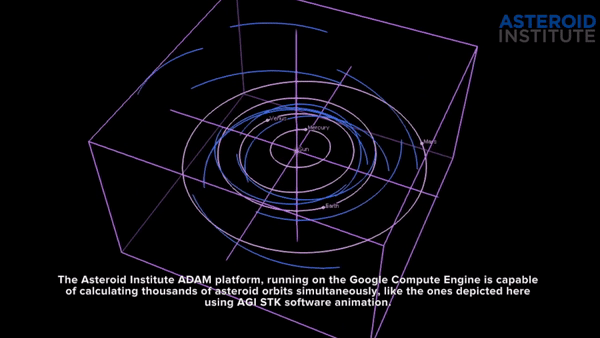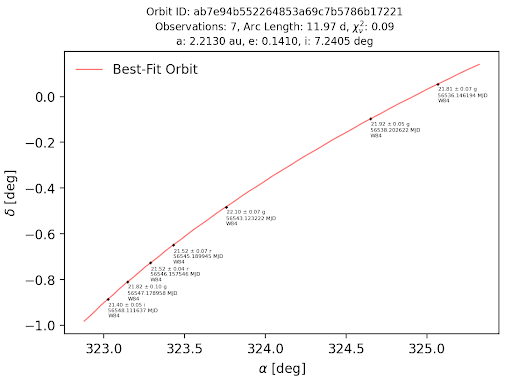DPS iPoster | The Asteroid Discovery Analysis and Mapping (ADAM) Platform
October 10, 2021
Presented at the 2021 conference of the Division for Planetary Sciences of the American Astronomical Society


The Asteroid Discovery, Analysis, and Mapping (ADAM) platform
Sarah Greenstreet, Ed Lu, Mario Juric, Joachim Moeyens, and the Asteroid Institute team
B612 Asteroid Institute, University of Washington
Abstract
The B612 Asteroid Institute has developed the Asteroid Discovery, Analysis, and Mapping (ADAM) platform to analyze and understand asteroid data sets. ADAM uses Google Compute Engine to perform precision cloud-based asteroid orbit propagations, orbit determination, targeted deflections, Monte Carlo impact probability calculations, and orbit visualizations. Our vision with ADAM is to create a cloud-based astrodynamics platform available to the scientific community that provides a unified interface to multiple tools and enables large-scale studies. ADAM includes pre-configured settings to match common practices, such as the use of various time standards and coordinate frames, removing the need for users to perform any necessary transformations for comparison to results from external tools. ADAM’s architecture consists of a web-service front-end, cloud-based storage, and cloud-based compute engines encapsulating multiple tools for computation and analysis. At the core of ADAM’s orbit propagation, targeting capabilities, and impact probability computations are a number of open source astrodynamics packages as well as the Analytical Graphics Inc. (AGI)’s Systems Tool Kit (STK) Components Segmented Propagation Library. The astrodynamics software “Astrogator” (included with Components) has been used internationally for pre-launch mission analysis and in operations on numerous commercial and government Earth-orbiting, lunar, and deep space missions, such as the WMAP, CONTOUR, LCROSS, IBEX, LADEE, LRO, MAVEN, MESSENGER, and New Horizons missions.
We present a study performed with ADAM to investigate the distribution of deflection delta-v required to divert asteroids on Earth impact trajectories as a function of time prior to impact for 10,000 synthetic impacting asteroids, calculating the distribution of deflection delta-v required if applied 10, 20, 30, 40, and 50 years prior to impact (Greenstreet et al., 2020). We also present the ongoing work to compute impact probabilities for the 10,000 synthetic impactors for six different size bins (a total of 60,000 synthetic impactors) over the 50 year period before impact sampled every 1-10 years. Lastly, we describe the integration of the Tracklet-less Heliocentric Orbit Recovery (THOR) algorithm (see abstract by J. Moeyens) into ADAM to utilize it’s cloud-computing capabilities to discover even the trickiest-to-find asteroids among current survey data.
ADAM: ASTEROID DISCOVERY & ANALYSIS MAPPING PLATFORM
The Asteroid Institute is a virtual collaboration with the goal of working to protect the Earth from asteroid impacts and informing and forwarding world-wide decision-making on planetary defense issues.
One of the technical projects of the Asteroid Institute is the Asteroid Discovery and Analysis Mapping (ADAM) platform. ADAM uses Google Compute Engine to perform precision cloud-based asteroid orbit propagations, orbit determination, targeted deflections, Monte Carlo impact probability calculations, and orbit visualizations. Our vision with ADAM is to create a cloud-based astrodynamics platform available to the scientific community that provides a unified interface to multiple tools and enables large-scale studies. ADAM includes pre-configured settings to match common practices, such as the use of various time standards and coordinate frames, removing the need for users to perform any necessary transformations for comparison to results from external tools. ADAM’s architecture consists of a web-service front-end, cloud-based storage, and cloud-based compute engines encapsulating multiple tools for computation and analysis.
At the core of ADAM’s orbit propagation, targeting capabilities, and impact probability computations are a number of open source astrodynamics packages as well as the Analytical Graphics Inc. (AGI)’s Systems Tool Kit (STK) Components Segmented Propagation Library. The astrodynamics software “Astrogator” (included with Components) has been used internationally for pre-launch mission analysis and in operations on numerous commercial and government Earth-orbiting, lunar, and deep space missions, such as the WMAP, CONTOUR, LCROSS, IBEX, LADEE, LRO, MAVEN, MESSENGER, and New Horizons missions.
ADAM is already proving to be a powerful tool that will be available to the scientific community upon development and testing completion. It will allow users to compute orbit determinations or deflection trajectories at scale with the additional benefit of visualizing those orbits and trajectories.
 Fig. 1: Screenshot from ADAM visualization animation. Full video can be found on YouTube here: http://www.youtube.com/watch?v=XqcKikByTjk&fs=1&modestbranding=1&rel=0&showinfo=0
Fig. 1: Screenshot from ADAM visualization animation. Full video can be found on YouTube here: http://www.youtube.com/watch?v=XqcKikByTjk&fs=1&modestbranding=1&rel=0&showinfo=0
IMPACT DEFLECTION STUDY
We present a study performed with ADAM to investigate the distribution of deflection delta-v required to divert asteroids on Earth impact trajectories as a function of time prior to impact for 10,000 synthetic impacting asteroids, calculating the distribution of deflection delta-v required if applied 10, 20, 30, 40, and 50 years prior to impact (Greenstreet et al., 2020).
Deflection technology: Kinetic impactor in prograde or retrograde direction
Impactor population: 10,000 virtual impactors from Chesley & Spahr (2004) adjusted by Peter Veres (personal comm., 2016) for newer gravity model
Deflection calculation method: STK’s differential corrector (i.e., “shooting” method) implemented in B612’s Google Cloud-based ADAM
Target miss distance: 2 Earth radii from Earth’s center
Time prior to impact delta-v applied: 10, 20, 30, 40, and 50 years
Goals: Produce histograms of deflection delta-v required for 10,000 impactors to miss Earth by targeted distance. Determine mean, median, minimum, and maximum delta-v for each time prior to impact. Determine fraction of impactors with planetary close encounters prior to impact that affect required delta-v. Analyze interesting impact scenarios discovered in deflection propagations.
Interesting Results:
1) Required delta-v distribution peak is roughly linear as a function of time before impact (see panel of histograms).
2) Maximum delta-v required for all five decades before impact studied is 2-3 magnitudes larger than the median required delta-v. These large delta-v requirements often correspond with impacts that occur when the impactor and target orbits are nearly parallel.
3) The number of impactors in the lowest delta-v bin (1e-7 – 0.05 cm/s) increases as a function of time before impact (0.57%, 2.3%, 4.9%, 7.7%, and 10.8% for 10, 20, 30, 40, and 50 years prior to impact, respectively). These impactors often experience intervening planetary close approaches that dramatically decrease the required delta-v.
4) In addition, we find that 0.06%, 0.34%, 1.2%, 3.0%, and 6.3% of impactors at 10, 20, 30, 40, and 50 years prior to impact, respectively, result in required delta-v below the threshold of the targeting limits of ADAM (i.e., delta-v < 1e-7 cm/s). These impactors also often experience intervening planetary close approaches that dramatically decrease the required delta-v.
5) Those impactors with the smallest required delta-v (either in the lowest delta-v bin or below ADAM’s targeting threshold; 0.6%, 2.6%, 6.1%, 10.7%, and 17.1% of impactors at 10, 20,
30, 40, and 50 years prior to impact, respectively) are those for which it is the most difficult to predict an impact due to the chaotic nature of the impactor orbits over time. Such impact scenarios will represent the most difficult deflection decision cases.
Delta-v Histograms & Statistics:

Fig. 2: Histograms of delta-v deflection requirements computed with ADAM for 10,000 synthetic impactors in 10-year increments covering the 50 years leading up to impact. Credit: Greenstreet, S., Lu, E., Loucks, M., Carrico, J., Kichkaylo, T., Juric, M., Required deflection impulses as a function of time before impact for Earth-impacting asteroids, 2020, Icarus, 347, 113792.
IMPACT PROBABILITY STUDY
In order to better understand the evolution of asteroid impact probabilities as additional observations are made and the point at which impacts are relatively certain, we also present the ongoing work to compute impact probabilities for the 10,000 synthetic impactors for six different size bins (a total of 60,000 synthetic impactors) over the 50 year period before impact sampled every 1-10 years. This work is currently ongoing and still in the testing phase.
Impactor population: 10,000 virtual impactors from Chesley & Spahr (2004) adjusted by Peter Veres (personal comm., 2016) for newer gravity model (same as for impact deflection study)
Impact probability calculation method: Monte Carlo simulations implemented in B612’s Google Cloud-based ADAM
Time prior to impact studied: 10, 20, 30, 40, and 50 years
Goals: To understand how impact probability changes as new observations are taken and to determine how long prior to impact we are likely to know for sure that an impact will occur.
Method:
1) Test data set defined: 5 simple impactors (no close approaches to any planet in 50 years leading up to impact) identified in our impactor population
2) Observation data set created for test data set:
- Spectral classes (⅓ S & ⅔ C) and geometric albedos assigned to impactor population
- Impactor physical properties duplicated for 8 different H-magnitude bins [18, 19, 20, 21, 22, 23, 24, 25]
- 19 years of simulated LSST operations stacked 9 times to cover 100 years of impacts for impactor population as well as 50 years before first impact (171 years simulated LSST pointings in total)
- Generated “in field of view” catalog of LSST pointings for impactors
- Created observations file (simulated LSST detections) for impactors, trimmed due to trailing losses and including astrometric errors using SNR and expected LSST seeing
3) Orbit determination performed: As a preliminary test, Bill Gray’s Find_Orb3 used to calculate cartesian state vectors and covariance matrices from simulated LSST observations of 5 simple impactors over 50 years before impact in cumulative 5-year increments of observations up 10 years before impact when switch to 1-year increments
- E.g., observations from 45-50 years before impact, 40-50 years before impact, 35-50…10-50 years before impact, 9-50…1-50 years before impact, 30-days-50 years before impact
4) ADAM impact probability Monte Carlo: Each cartesian state vector and associated covariance matrix for each time frame before impact for a given test data set simple impactor is uploaded to ADAM’s impact probability Monte Carlo capabilities through a python API. A specified number of state vector draws are made from the covariance, and all state vectors (nominal and covariance draws) are propagated to the known time of impact. The fraction of state vector propagations resulting in an impact (versus a miss) is used to determine the impact probability.
5) Impact probability evolution as a function of time before impact: Each computed impact probability from ADAM’s Monte Carlo propagations for the specified increments of time before impact are plotted.
Preliminary results: The impact probability evolution over the 50 years before impact for two synthetic impactors are shown below. The orbits are determined using Bill Gray’s Find_Orb3 for cumulative 5-year increments from 50 to 10 years before impact when cumulative 1-year increments are used (see text above). The number of observations included in the Find_Orb orbit fit (divided by 100) are shown in green. The impact probability computed using ADAM’s Monte Carlo propagations with 2,500 – 5,000 draws from the Find_Orb-generated covariance for the same observation cadence as above are shown in blue.

Fig. 3: Preliminary results of impact probability evolution for one of our synthetic impactors. See “Preliminary Results” text above for more information. This synthetic impactor has few observations available earlier than roughly 25 years before impact. Enough observations to compute an orbit do not become available until roughly 25 years before impact. At that time, an impact probability is computed. The impact probability rises from roughly 15% to 100% over the course of <10 years as the number of observations increases. We would not know this asteroid would impact the Earth until roughly 15 years before impact.

Fig. 4: Preliminary results of impact probability evolution for one of our synthetic impactors. See “Preliminary Results” text above for more information. This synthetic impactor has sufficient enough observations available by roughly 40 years before impact to increase the impact probability from nearly 0% at roughly 45 years before impact to 100%. We would not know this asteroid would impact the Earth with a longer warning time than the example shown in Figure 3 at roughly 40 years before impact.
Future Work:
- Continue testing accuracy of Monte Carlo simulations
- Continue testing Find_Orb orbit determination and covariance generation
- Eventually, expand testing from 5 simple impactors to full 10,000 impactor population for 6-8 different H-magnitude bins (60,000 – 80,000 impactors in total)
(https://github.com/Bill-Gray/find_orb)
ADAM & ASTEROID DISCOVERY
Here we describe the integration of the Tracklet-less Heliocentric Orbit Recovery (THOR) algorithm (see abstract 101.7 by J. Moeyens; https://arxiv.org/abs/2105.01056) into ADAM to utilize it’s cloud-computing capabilities to discover even the trickiest-to-find asteroids among current survey data. In brief, THOR can discover objects without the need for tracklets (pairs of intranightly detections) to be observed and instead can link observations at arbitrary cadences within a linking window. Removing the requirement for tracklets to be observed enables the discovery of minor planets in telescopic data sets that were not typically suited for Solar System discovery (the vast majority of data sets). The integration of THOR into the ADAM platform allows us to utilize the computational power of the Cloud required to extract these asteroids from the data, adding asteroid discovery to the list of ADAM capabilities.
THOR “as a service” is currently being integrated into ADAM as a python API. THOR is being run through ADAM initially on 2-week data sets of observations from the Zwicky Transient Facility (ZTF) and the Dark Energy Survey (DES) to extract previously-undiscovered asteroids among the observations. We envision that users and astronomical surveys alike can submit their catalogues of observations to the ADAM discovery service and have those observations be processed using THOR for as-yet-undiscovered objects. These candidate discoveries can then be returned to the user and/or submitted to the Minor Planet Center.

Fig. 5: Example discovery candidate recovered from the NOIRLab Source Catalog (Nidever et al. 2020) which contains detections extracted from Dark Energy Survey (DES) images. This candidate was recovered with no tracklets and instead purely recovered with single-night observations (singletons).
ADVANTAGES OF ADAM IN GOOGLE COMPUTE ENGINE
During initial tests for the impact deflection study, before ADAM development began, the calculation for all 10,000 asteroids was run using the desktop version of the STK software upon which ADAM is built. The asteroids could only be run in batches of 5-10 at a time, and calculating the required “nudges” if applied 30 years prior to impact for all 10,000 asteroids took months to complete.
With the implementation of the STK software in Google Compute Engine, ADAM can allow us to run the calculation for all 10,000 asteroids simultaneously in about 24 hours with 50 years before their impending impacts!

Credit/ cloud.google.com
This is very exciting, because ADAM not only allows us to run faster computations, but to study the effects of more various factors on our results, such as how much time prior to the impact the “nudge” is applied. Without ADAM, it would not be possible for us to study the “nudges” needed 10, 20, 30, 40, and 50 years prior to impact because the computation time would be too great.
Similarly, the extravagant number of Monte Carlo simulations needed for our impact probability study would not be possible without the implementation of ADAM in the Cloud. We have 60,000 – 80,000 impactors, each currently with 18 state vectors (for the given time intervals before impact), for a total of ~1-1.5 million state vectors. With 5,000-10,000 covariance draws a piece for the Monte Carlo runs, that is a grand total of ~5-15 billion propagations that will eventually be run for this study once testing is completed. Such a vast number of propagations is only feasible with ADAM’s Cloud-based computation architecture.
In addition, running THOR on the large number of observations available in current and archival survey data sets with thousands of potential test-orbits needed in order to identify previously undiscovered asteroids in those data sets, is made much easier within ADAM’s cloud-based structure. By integrating THOR into ADAM we hope to provide the planetary science community with “discovery-as-a-service”. The scalability of a cloud-based platform such as ADAM is perfectly suited to meet the computational needs of a discovery algorithm such as THOR. Users will be able to submit their catalogues of observations to the ADAM discovery service, have those observations processed using THOR, and potential discovery candidates returned to them. The integration of THOR into ADAM opens the door to the possibility of discovering as yet undiscovered minor planets in data sets that are not typically suited for discovery searches — thereby enabling the discovery of the hardest to find populations of asteroids.
In conclusion, ADAM is very powerful and unique in its capabilities to do these types of impact deflection, impact probability, and asteroid discovery computations!
ACKNOWLEDGEMENTS
The Asteroid Institute is a program of B612 Foundation, and was made possible by major gifts to support the ADAM project provided by the W.K. Bowes Jr. Foundation, Steve Jurvetson, The P. Rawls Family Fund, Tito’s Handmade Vodka, Yishan Wong and Kimberly Algeri-Wong and two anonymous donors, along with Founding Circle and Asteroid Circle members: AGI (in-kind), B. Anders, R. Armstrong, G. Baehr, The Barringer Crater Company, B. Burton, D. Carlson, S. Cerf, V. Cerf, C. Chapman, Y. Chapman, J. Chervenak, D. Corrigan, E. Corrigan, A. Denton, E. Dyson, A. Eustace, A. Fritz, L. Fritz, S. Galitsky, E. Gillum, L. Girand, Glaser Progress Foundation, Google Cloud (in-kind), D. Glasgow, J. Grimm, S. Grimm, G. Gruener, V. K. Hsu & Sons Foundation Ltd., J. Huang, J. D. Jameson, J. Jameson, M. Jonsson Family Foundation, D. Kaiser, S. Krausz, V. Lasas, J. Leszczenski, D. Liddle, S. Mak, G.McAdoo, S. McGregor, J. Mercer, M. Mullenweg, D. Murphy, P. Norvig, S. Pishevar, R. Quindlen, N. Ramsey, R. Rothrock, E. Sahakian, R. Schweickart, A. Slater, T. Trueman, F. B. Vaughn, R. C. Vaughn, M. Welty, S. Welty, B. Wheeler, M. Wyndowe, and seven anonymous donors in addition to donors from over 46 countries around the world.
S. Greenstreet, M. Jurić, and J. Moeyens acknowledge the support from the University of Washington College of Arts and Sciences, Department of Astronomy, and the DIRAC Institute. The DIRAC Institute is supported through generous gifts from the Charles and Lisa Simonyi Fund for Arts and Sciences and the Washington Research Foundation. M. Jurić wishes to acknowledge the support of the Washington Research Foundation Data Science Term Chair fund, and the University of Washington Provost’s Initiative in Data-Intensive Discovery.















